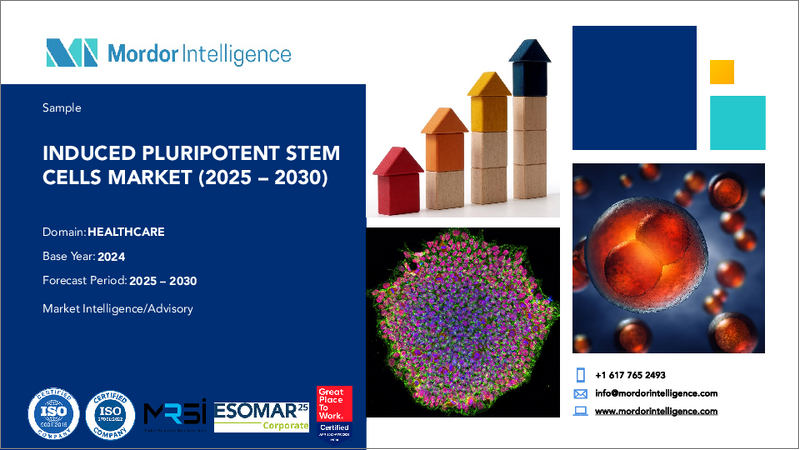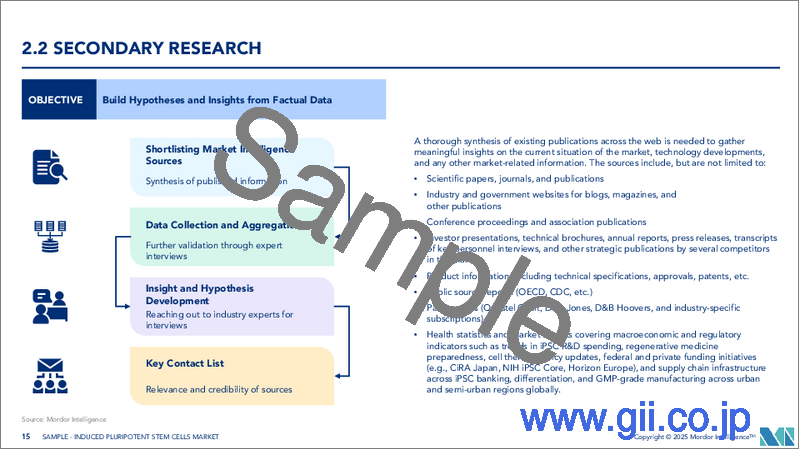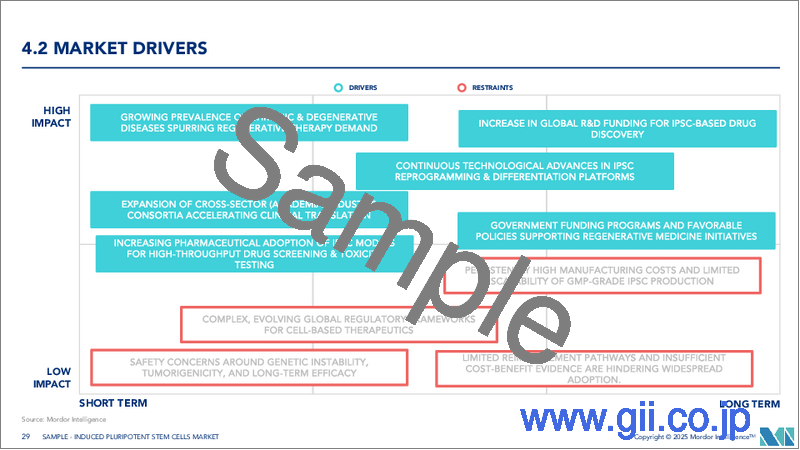|
|
市場調査レポート
商品コード
1407039
iPS細胞(人工多能性幹細胞):市場シェア分析、産業動向・統計、2024~2029年成長予測Induced Pluripotent Stem Cells - Market Share Analysis, Industry Trends & Statistics, Growth Forecasts 2024 - 2029 |
||||||
カスタマイズ可能
適宜更新あり
|
|||||||
| iPS細胞(人工多能性幹細胞):市場シェア分析、産業動向・統計、2024~2029年成長予測 |
|
出版日: 2024年01月04日
発行: Mordor Intelligence
ページ情報: 英文 110 Pages
納期: 2~3営業日
|
全表示
- 概要
- 目次
iPS細胞(人工多能性幹細胞)の世界市場規模は、2024年の12億米ドルから2029年には19億9,000万米ドルに成長し、予測期間(2024-2029年)のCAGRは10.10%となる見込みです。
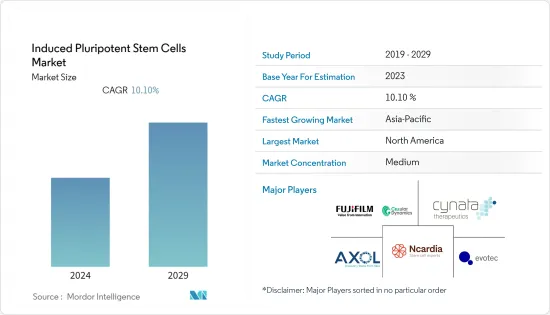
COVID-19パンデミックは、ウイルス感染のリスクを低下させるため、COVID-19パンデミック期間中はほとんどの慢性治療が延期され、すべての外来治療が延期または制限されたため、ヘルスケア部門に大きな負担を課しました。細胞療法に関するいくつかの研究では、細胞機能を制御し、炎症性サイトカインをダウンレギュレートすることによって免疫反応を調節する可能性が示されており、COVID-19患者の死亡率と罹患率を低下させるのに役立っています。例えば、2022年2月にMolecular Biomedical誌に掲載された論文によると、幹細胞は免疫系を変化させることでCOVID-19疾患を治療する臨床研究において有望な結果を示しています。さらに、2021年9月に『Frontiers in Cell and Development Biology』誌に掲載された論文によると、ヒトiPS細胞(人工多能性幹細胞)(iPSC)由来の細胞モデルやオルガノイドモデルが、ウイルスのライフサイクルのin vitroシミュレーションや、コロナウイルスの再出現を防ぐための薬剤スクリーニングに有用なプラットフォームとなることが観察されています。また、これらのiPSC由来モデルは、様々なヒト細胞型の機能と生理を再現し、複雑な微小環境を構築することができるため、ウイルス感染メカニズムの研究効率を高め、実際の宿主とウイルスの相互作用を模倣することができます。このように、幹細胞の利用が増加したことで、市場はパンデミック期に大きな成長を遂げました。
幹細胞治療の研究開発活動の増加や個別化医療の急増といった要因が、予測期間中の市場成長を押し上げると予想されます。
様々な疾患治療のための個別化医薬品の普及の高まりは、治療法の開発におけるiPS細胞(人工多能性幹細胞)の採用を加速させるために、企業の集中力を高めると予想されます。例えば、2022年8月にJournal of Personalized Medicine誌に掲載された論文によると、様々な単発性および多発性疾患の患者から作製されたiPS細胞は、精神疾患の個別化モデルを開発するための貴重なリソースとなり、研究者が基礎となる分子および細胞経路をより深く理解するのに役立つことが確認されています。また、同誌によると、研究者らは、大うつ病性障害(MDD)のリンパ芽球細胞株(LCL)をiPSCに再プログラムし、大脳皮質ニューロンに分化させたもので、シナプス結合や形態の変化、特異的な遺伝子発現を含む、ブプロピオン反応のバイオマーカーを発見したとのことです。このように、いくつかのバイオマーカーを得るためにLCLを利用することで、MDDに苦しむ患者に対する個別化治療の選択肢が促進され、それによって市場の成長が促進されると期待されています。
さらに、契約、提携、その他の取り組みなど、さまざまな事業戦略の採用に注力する企業が増加していることから、臨床研究におけるiPSCの利用や生産が増加し、市場成長に寄与すると期待されています。例えば、センチュリー・セラピューティクスは2022年1月、ブリストル・マイヤーズスクイブと、血液悪性腫瘍および固形がんを対象とした、iPS細胞(人工多能性幹細胞)由来の人工ナチュラルキラー細胞(「iNK」)および/またはT細胞(「iT」)プログラムを最大4つまで開発・商業化するための研究提携およびライセンス契約を締結しました。また、2021年11月には、ヒト多能性幹細胞企業であるNcardiaが、幹細胞の探索および商業生産サービスを拡大するために、キニシチと6,000万米ドルの資金調達契約を締結しました。
したがって、医薬品やその他の治療法の研究開発におけるiPS細胞(人工多能性幹細胞)の活用に注力する企業の増加や、個別化医療に対する需要の高まりなど、前述の要因により、調査対象市場は予測期間中に成長すると予想されます。しかし、幹細胞治療に関する認知度の低さや治療費の高さが、予測期間中のiPS細胞(人工多能性幹細胞)市場の成長を妨げる可能性が高いです。
iPS細胞(人工多能性幹細胞)(iPSC)市場の動向
再生医療分野が予測期間中に大きな成長を遂げる見込み
iPS細胞は、異なる転写因子を用いて体細胞から再プログラムされた細胞であり、これらの細胞は自己複製というユニークな性質を持ち、様々な細胞系譜に分化することができます。再生医療では、損傷したり変性したりした組織を、iPS細胞の助けを借りて研究室で生産し、損傷や変性のある場所に移植することで修復します。さらに、iPSCは胚ではなく成人の体細胞から作られるため、再生医療や創傷治癒のモデルにおいて、他の幹細胞よりもいくつかの利点があります。したがって、iPSCは胚性幹細胞の使用にまつわる倫理的な懸念とは無縁です。
再生医療分野では、再生医療研究におけるiPSCの採用の増加や企業活動の活発化などの要因により、予測期間中にiPS細胞(人工多能性幹細胞)市場が大きく成長することが予想されます。
iPS細胞(人工多能性幹細胞)に関連する調査件数の増加は、市場成長を促進する主要因です。例えば、インディアナ大学が2022年5月に発表した研究によると、インディアナ大学医学部の研究者らは、アラバマ大学バーミンガム校および他の5つの機関と共同で、2型糖尿病によって引き起こされる血管健康合併症、特に網膜血管をよりよく管理するための新しい再生医療技術を調査しました。その結果、hiPSCから形成される特定の中胚葉サブグループを、安全かつ効果的、持続的に誘導し、虚血組織の救済や血管障害者の血管修復のための新しい治療法として使用できることが示されました。さらに、同じ情報源によれば、研究者らは、糖尿病患者および非糖尿病患者の末梢血細胞を遺伝子工学的にhiPSCに形質転換し、この細胞を独自の血管修復細胞に成熟させ、多施設での初期段階試験に用いたとのことです。血管灌流の回復に伴い、2型糖尿病マウス(T2D)の網膜機能障害モデル動物に注入したところ、視力と網膜電図が大幅に改善しました。このように、糖尿病患者の網膜機能障害の治療におけるiPSCの成果は、ヒト疾患の調査設計や細胞治療における利用を増加させ、それゆえ市場の成長を促進しています。
さらに、様々な疾患の治療のために幹細胞を用いた治療法の生産を促進し、幹細胞研究センターを設立するための政府資金の増加は、その採用を増加させ、それゆえ市場成長を促進すると予想されます。例えば、オーストラリア政府の保健・高齢者医療省によると、2022年3月、幹細胞治療(SCT)ミッションは、新規かつ安全で効率的な幹細胞治療法の開発に1億5,000万米ドルを投資し、医療成果の向上を目指しています。同ミッションは、革新的で安全かつ効率的な医療療法を開発するイニシアティブに資金を提供し、患者の福祉や労働力の生産性を高め、商業用幹細胞製品の開発を促進します。
さらに、iPSCを用いた再生医療開発における企業活動の活発化も、同分野の成長に寄与しています。例えば、2022年6月、SQZ Biotechnology Company社は、同社独自のCell Squeeze技術を用いて、特定の運命を決定する転写因子をコードする6種類のRNAをワンステップで導入することにより、ヒトiPS細胞(人工多能性幹細胞)(iPSC)からドーパミン作動性(DA)ニューロンを作製しました。この新たな発見は、同社が最近発表した再生医療研究に貢献するものであり、パーキンソン病を含む神経疾患に対する細胞代替治療薬の開発というNIHの資金提供によるイニシアチブをサポートするものです。
したがって、幹細胞研究に対する政府助成金の増加や調査件数の増加といった前述の要因により、調査対象セグメントは予測期間中に成長すると予想されます。
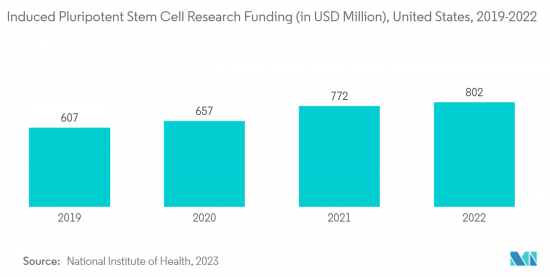
北米が予測期間中に大きな市場シェアを占める見込み
北米は、医薬品開発、毒性試験、疾患モデリングにおいて高度な技術やシステムの採用が増加していること、また同地域で幹細胞治療が受け入れられつつあることなどの要因から、予測期間中に同市場において大きなシェアを占めると予想されます。
iPSC研究のための研究資金が増加していることも、同地域の市場成長を促進すると予想されます。例えば、NIHが発表したデータによると、2022年5月、米国における幹細胞-誘導多能性幹細胞の研究開発を支援するために、2021年の7億1,300万米ドルに対し、2022年には推定7億4,000万米ドルが政府から資金提供されました。iPSCへのこのような巨額の投資は、その採用を増加させ、市場成長を促進すると予想されます。
さらに、同社による新製品の発売や施設の拡張活動は、市場における新規iPSC療法の利用可能性を高め、ひいては市場の成長を増大させると予想されます。例えば、2022年5月、IN8bio, Inc.は、ワシントンで開催された米国遺伝子細胞治療学会(ASGCT)年次総会において、新しいiPS細胞(人工多能性幹細胞)(iPSC)ベースのガンマ・デルタT細胞プラットフォームを発表しました。このプラットフォームは、"既製品"である細胞療法のスケールアップ製造を可能にする技術を進歩させるもので、IN8bioの開発における新たな段階を示すものです。また、2022年4月、Ncardia社は、同社のiPS細胞(人工多能性幹細胞)(iPSC)の専門知識を細胞療法の開発・製造分野に集中させるため、新事業としてCellistic社を立ち上げました。この戦略は、同社の現在の創薬ソリューション事業を基礎とし、iPSCの分化・拡大に関する深い専門知識を活用して、信頼性の高い細胞特異的製造プラットフォームの開発など、拡大するiPSC細胞治療ソリューションの需要に対応するための専用リソースと能力を集中させるものです。
したがって、iPSC研究に対する政府資金の増加や新製品の上市といった前述の要因により、調査対象市場は予測期間中に成長すると予想されます。
iPS細胞(人工多能性幹細胞)(iPSC)産業の概要
iPS細胞(人工多能性幹細胞)市場は競争が激しく、複数の主要企業で構成されています。各社は、市場での地位を維持するために、合併、提携、買収、パートナーシップ、製品発表など様々な主要戦略の採用に注力しています。市場に参入している企業には、Axol Bioscience Ltd.、Cynata Therapeutics Limited、Evotec SE、FUJIFILM Cellular Dynamics, Inc.、Ncardia、Pluricell Biotech、REPROCELL USA, Inc.などがあります。
その他の特典:
- エクセル形式の市場予測(ME)シート
- 3ヶ月間のアナリスト・サポート
目次
第1章 イントロダクション
- 調査の前提条件と市場定義
- 調査範囲
第2章 調査手法
第3章 エグゼクティブサマリー
第4章 市場力学
- 市場概要
- 市場促進要因
- 幹細胞治療における研究開発活動の増加
- 個別化医療の採用急増
- 市場抑制要因
- 幹細胞治療に対する認識不足と治療費の高騰
- ポーターのファイブフォース分析
- 新規参入業者の脅威
- 買い手/消費者の交渉力
- 供給企業の交渉力
- 代替品の脅威
- 競争企業間の敵対関係の強さ
第5章 市場セグメンテーション
- 由来細胞タイプ別
- 肝細胞
- 線維芽細胞
- ケラチノサイト
- ニューロン
- その他
- 用途別
- 医薬品開発
- 再生医療
- 毒性試験
- 組織工学
- 細胞治療
- 疾患モデリング
- エンドユーザー別
- 研究機関
- その他のエンドユーザー
- 地域別
- 北米
- 米国
- カナダ
- メキシコ
- 欧州
- ドイツ
- 英国
- フランス
- イタリア
- スペイン
- その他欧州
- アジア太平洋
- 中国
- 日本
- インド
- オーストラリア
- 韓国
- その他アジア太平洋地域
- 中東・アフリカ
- GCC
- 南アフリカ
- その他中東とアフリカ
- 南米
- ブラジル
- アルゼンチン
- その他南米
- 北米
第6章 競合情勢
- 企業プロファイル
- Axol Bioscience Ltd.
- Cynata Therapeutics Limited
- Evotec SE
- Fate Therapeutics, Inc.
- FUJIFILM Cellular Dynamics, Inc.
- Ncardia
- LizarBio Therapeutics(Pluricell Biotech)
- REPROCELL USA, Inc.
- Sumitomo Dainippon Pharma Co., Ltd.
- Takara Bio, Inc.
- Thermo Fisher Scientific, Inc.
- ViaCyte, Inc.
第7章 市場機会と今後の動向

The Global Induced Pluripotent Stem Cells Market size is expected to grow from USD 1.2 billion in 2024 to USD 1.99 billion by 2029, at a CAGR of 10.10% during the forecast period (2024-2029).
The COVID-19 pandemic has imposed a great burden on the healthcare sector as most chronic therapies were postponed and all outpatient treatments were delayed or restricted during the COVID-19 pandemic to lower the risk of viral transmission. Several studies on cell therapies have demonstrated their potential to modulate the immune response by controlling cell function and downregulating inflammatory cytokines, which aids in lowering COVID-19 patients' mortality and morbidity rates. For instance, according to an article published in Molecular Biomedical, in February 2022, stem cells have demonstrated promising results in clinical studies for treating COVID-19 disease by altering the immune system. In addition, as per an article published in Frontiers in Cell and Development Biology, in September 2021, it has been observed that human induced pluripotent stem cell (iPSC)-derived cellular and organoid models provide useful platforms for in vitro simulation of viral life cycles and drug screening to prevent coronavirus reemergence. Also, these iPSC-derived models can recapitulate the functions and physiology of various human cell types and assemble complex microenvironments, hence increasing the study efficiency of viral infection mechanisms, and mimicking the actual host-virus interaction. Thus, with the increased use of stem cells, the market has witnessed significant growth during the pandemic.
Factors such as the increase in R&D activities in stem cell therapies and the surge in the adoption of personalized medicines are expected to boost market growth over the forecast period.
The rise in the prevalence of personalized medicines for various disease treatments is expected to increase the company's focus to accelerate the adoption of induced pluripotent stem cells in developing therapies. For instance, as per an article published in the Journal of Personalized Medicine, in August 2022, it has been observed that iPSCs generated from individuals with a variety of monogenic and polygenic disorders, provide a valuable resource for developing individualized models of psychiatric diseases that help researchers to better understand the underlying molecular and cellular pathways. The same source also stated that the researchers discovered biomarkers, including synaptic connectivity and morphology changes as well as specific gene expression, for the bupropion response in lymphoblastoid cell lines (LCLs) from major depressive disorder (MDD) that had been reprogrammed to iPSC and differentiated into cortical neurons. Thus, the utilization of LCLs in obtaining several biomarkers is expected to promote personalized treatment options for patients suffering from MDD, thereby bolstering market growth.
Moreover, the growing company's focus on adopting various business strategies such as agreements, collaborations, and other initiatives is expected to increase the utilization and production of iPSCs in clinical research, thereby contributing to market growth. For instance, in January 2022, Century Therapeutics signed a research collaboration and license agreement with Bristol Myers Squibb to develop and commercialize up to four induced pluripotent stem cell-derived, engineered natural killer cell ('iNK') and/or T cell ('iT') programs for hematologic malignancies and solid tumors. Also, in November 2021, Ncardia, a human-induced pluripotent stem cell company, signed a USD 60 million funding deal with Kiniciti to expand discovery and commercial production services for stem cells.
Therefore, owing to the aforementioned factors, such as increasing company focus on utilizing induced pluripotent stem cells in the R&D of drugs and other therapies as well as growing demand for personalized medicines, the studied market is anticipated to grow over the forecast period. However, the lack of awareness regarding stem cell therapies and the high cost of treatment is likely to hinder the growth of the induced pluripotent stem cells market over the forecast period.
Induced Pluripotent Stem Cells (iPSCs) Market Trends
Regenerative Medicine Segment is Expected to Witness Significant Growth Over the Forecast Period
iPSCs are the cells that are reprogrammed from somatic cells using different transcription factors and these cells possess unique properties of self-renewal and can differentiate into a variety of cell lineages. In regenerative medicine, damaged or degenerating tissues are restored by being produced in labs with the aid of iPSCs and then transplanted to the location of the damage or degeneration. Additionally, iPSC offers several advantages over other stem cell types in models of regenerative medicine and wound healing as they are produced from adult somatic cells rather than embryos. Thus, iPSCs are not associated with the ethical concerns that surround the use of embryonic stem cells.
The regenerative medicines segment is expected to witness significant growth in the induced pluripotent stem cells market over the forecast period owing to the factors such as the rising adoption of iPSCs in regenerative medicine research and increasing company activities.
The increasing number of research studies related to induced pluripotent stem cells is the key factor driving the market growth. For instance, according to a study published by Indiana University, in May 2022, the researchers at Indiana University School of Medicine in collaboration with the University of Alabama at Birmingham and five other institutions investigated novel regenerative medicine techniques to better manage vascular health complications, especially in a retinal vessel, caused by type 2 diabetes. The results show that a specific mesoderm subgroup formed from hiPSCs can be safely, effectively, and persistently derived for use as a new therapeutic to rescue ischemic tissues and repair blood vessels in people with vascular disorders. Additionally, the same source stated that the researchers genetically transformed diabetic and non-diabetic peripheral blood cells into hiPSCs, maturing the cells into unique blood vessel reparative cells, for the multi-site early phase study. With the restoration of vascular perfusion, the effects of injection into animal models of type 2 diabetic mice (T2D) retinal dysfunction demonstrated a considerable improvement in visual acuity and electroretinograms. Thus, the iPSCs' results in treating diabetic patients' retinal impairment have increased their use in study design and cell therapy for human disorders, hence propelling market growth.
Furthermore, the increasing government funding to promote the production of stem cell-based therapies for treating various diseases as well as establishing stem cell research centers are expected to increase its adoption, hence propelling the market growth. For instance, as per the Australian Government Department of Health and Aged Care, in March 2022, the Stem Cell Therapies (SCT) Mission invested USD 150 million in the development of novel, secure, and efficient stem cell therapies to increase health outcomes. The mission provides funding for initiatives that develop innovative, safe, and efficient medical therapies that enhance patient well-being, workforce productivity, and the development of commercial stem cell products.
Moreover, the rising company activities in developing regenerative medicines using iPSC are also contributing to segment growth. For instance, in June 2022, SQZ Biotechnology Company generated dopaminergic (DA) neurons from human induced pluripotent stem cells (iPSCs), using the company's proprietary Cell Squeeze technology, through the single-step delivery of six RNA that encodes for specific fate-determining transcription factors. The new findings contribute to the company's recent presentations on regenerative medicine research and support its NIH-funded initiative to develop cell replacement therapeutics for neurological diseases including Parkinson's disease.
Therefore, owing to the aforementioned factors such as growing government funding for stem cell research and the rising number of research studies, the studied segment is expected to grow over the forecast period.

North America is Expected to Have the Significant Market Share Over the Forecast Period
North America is anticipated to hold a significant market share in the market over the forecast period owing to the factors such as the rising adoption of highly advanced technologies and systems in drug development, toxicity testing, and disease modeling, coupled with the growing acceptance of stem cell therapies in the region.
The growing research funding for iPSC research is also expected to propel market growth in the region. For instance, according to the data published by NIH, in May 2022, an estimated USD 740 million was funded by the government to support the research and development of stem cells-induced pluripotent stem cells in the United States in 2022, as compared to USD 713 million in 2021. Such a huge investment in iPSC is anticipated to increase its adoption, hence propelling market growth.
Moreover, the new product launches and facility-expanding activities by the company increase the availability of novel iPSC therapies in the market, which in turn is anticipated to augment the market growth. For instance, in May 2022, IN8bio, Inc. launched a new induced pluripotent stem cell (iPSC) based gamma-delta T cell platform at the American Society for Gene and Cell Therapy (ASGCT) Annual Meeting in Washington. This platform represents a new stage in IN8bio's development as it advances technology that is intended to allow for the scaled manufacturing of cellular therapies that are "off-the-shelf." Also, in April 2022, Ncardia launched Cellistic, a new business, to focus the company's induced pluripotent stem cell (iPSC) expertise on the cell therapy development and manufacturing sector. This strategy builds on the company's current drug discovery solutions business and takes advantage of the firm's in-depth expertise in iPSC differentiation and expansion to concentrate dedicated resources and capabilities to address the expanding demand for iPSC cell therapy solutions, including the development of reliable cell-specific manufacturing platforms.
Therefore, owing to the aforementioned factors, such as growing government funding for iPSC research and new product launches, the studied market is expected to grow over the forecast period.
Induced Pluripotent Stem Cells (iPSCs) Industry Overview
The induced pluripotent stem cells market is competitive and consists of several key players. The companies are focusing on adopting various key strategies such as mergers, collaborations, acquisitions, partnerships, and product launches to withhold their position in the market. Some of the companies in the market are Axol Bioscience Ltd., Cynata Therapeutics Limited, Evotec SE, FUJIFILM Cellular Dynamics, Inc., Ncardia, Pluricell Biotech, and REPROCELL USA, Inc. among others.
Additional Benefits:
- The market estimate (ME) sheet in Excel format
- 3 months of analyst support
TABLE OF CONTENTS
1 INTRODUCTION
- 1.1 Study Assumptions and Market Definition
- 1.2 Scope of the Study
2 RESEARCH METHODOLOGY
3 EXECUTIVE SUMMARY
4 MARKET DYNAMICS
- 4.1 Market Overview
- 4.2 Market Drivers
- 4.2.1 Increase in Research and Development Activities in Stem Cells Therapies
- 4.2.2 Surge in Adoption of Personalized Medicine
- 4.3 Market Restraints
- 4.3.1 Lack of Awareness Regarding Stem Cell Therapies and High Cost of Treatment
- 4.4 Porter's Five Forces Analysis
- 4.4.1 Threat of New Entrants
- 4.4.2 Bargaining Power of Buyers/Consumers
- 4.4.3 Bargaining Power of Suppliers
- 4.4.4 Threat of Substitute Products
- 4.4.5 Intensity of Competitive Rivalry
5 MARKET SEGMENTATION
- 5.1 By Derived Cell Type
- 5.1.1 Hepatocytes
- 5.1.2 Fibroblasts
- 5.1.3 Keratinocytes
- 5.1.4 Neurons
- 5.1.5 Others
- 5.2 By Application
- 5.2.1 Drug Development
- 5.2.2 Regenerative Medicine
- 5.2.3 Toxicity Testing
- 5.2.4 Tissue Engineering
- 5.2.5 Cell Therapy
- 5.2.6 Disease Modeling
- 5.3 By End User
- 5.3.1 Research Institutions
- 5.3.2 Other End Users
- 5.4 Geography
- 5.4.1 North America
- 5.4.1.1 United States
- 5.4.1.2 Canada
- 5.4.1.3 Mexico
- 5.4.2 Europe
- 5.4.2.1 Germany
- 5.4.2.2 United Kingdom
- 5.4.2.3 France
- 5.4.2.4 Italy
- 5.4.2.5 Spain
- 5.4.2.6 Rest of Europe
- 5.4.3 Asia-Pacific
- 5.4.3.1 China
- 5.4.3.2 Japan
- 5.4.3.3 India
- 5.4.3.4 Australia
- 5.4.3.5 South Korea
- 5.4.3.6 Rest of Asia-Pacific
- 5.4.4 Middle East and Africa
- 5.4.4.1 GCC
- 5.4.4.2 South Africa
- 5.4.4.3 Rest of Middle East and Africa
- 5.4.5 South America
- 5.4.5.1 Brazil
- 5.4.5.2 Argentina
- 5.4.5.3 Rest of South America
- 5.4.1 North America
6 COMPETITIVE LANDSCAPE
- 6.1 Company Profiles
- 6.1.1 Axol Bioscience Ltd.
- 6.1.2 Cynata Therapeutics Limited
- 6.1.3 Evotec SE
- 6.1.4 Fate Therapeutics, Inc.
- 6.1.5 FUJIFILM Cellular Dynamics, Inc.
- 6.1.6 Ncardia
- 6.1.7 LizarBio Therapeutics (Pluricell Biotech)
- 6.1.8 REPROCELL USA, Inc.
- 6.1.9 Sumitomo Dainippon Pharma Co., Ltd.
- 6.1.10 Takara Bio, Inc.
- 6.1.11 Thermo Fisher Scientific, Inc.
- 6.1.12 ViaCyte, Inc.
